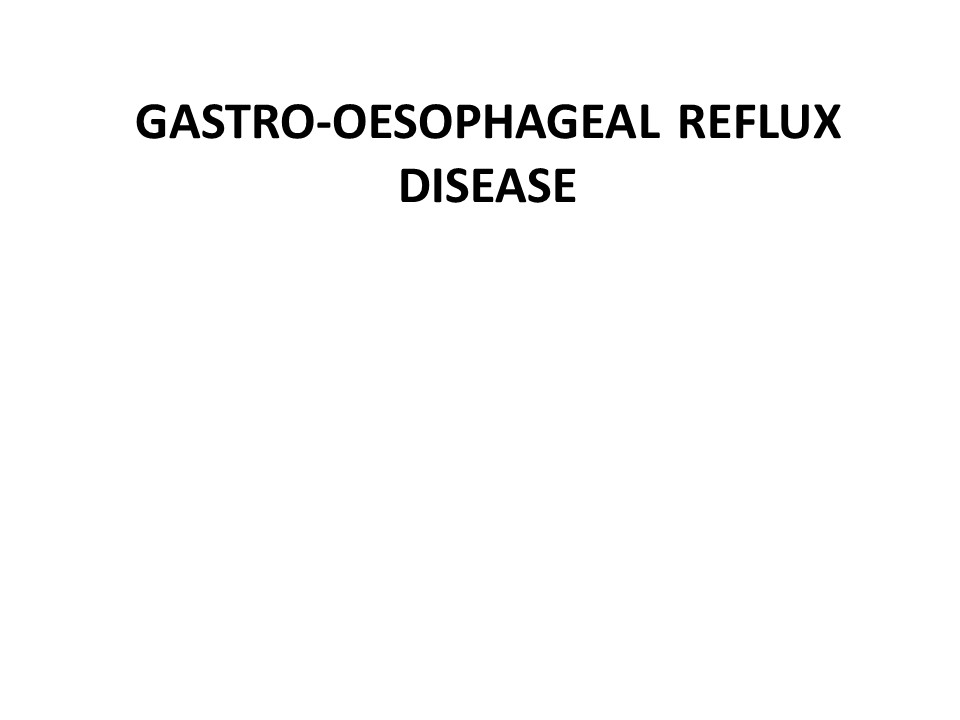GERD AND BARRETS PowerPoint PPT Presentation
Title: GERD AND BARRETS
1
GASTRO-OESOPHAGEAL REFLUX DISEASE
2
INTRODUCTION
- Dyspepsia is defined as upper abdominal or
retrosternal pain,discomfort,heartburn,nausea
vomiting or symptoms considered to be referable
to the proximal alimentary tract. - It is a symptom complex rather than a specific
disease - It is a common complaint among patients in both
general and gastroenterology practice.
3
Definition
- Is a clinical manifestation of excessive reflux
of acid gastric contents into the oesophagus
causing various degrees of symptomatic irritation
to the oesophageal mucosa with symptoms lasting
gt6monthsGORD runs a chronic and relapsing
courseTypical symptoms of GORD include
heartburn, regurgitation and dysphagia.
4
Epidemiology
- Is a very common disorder of the upper GIT
- Based on hospitalization and death rates the
prevalence of GORD has increased while that of
PUD has been on the decrease. - GORD affects about 25-35 of the US population
- Limited no of hospital based studies have
reported on GORD and its complication in African
countries.
5
- Ahmed et al reported 45 of patients with Erosive
oesophagitis, Barretts 10.6 in a study of 105
Sudanese patients with heartburn. - In South Africa out of 216 consecutive Barretts
only 5 were blacks despite the ratio of blacks
to whites in the city being 51.(Mason et al)
6
RISK FACTORS
- 1 Obesity
- 2 Smoking
- 3 Diet (fatty/spicy foods, peppermint, chocolate,
citrus fruits, tomato based products, coffee) - 4 Hiatus hernia
7
PATHOPHYSIOLOGY
- -Results from an imbalance between defensive
factors protecting the oesophagus (anti-reflux
barriers, oesophageal acid clearance and tissue
resistance) and aggressive factors from the
stomach contents (gastric acidity and vol. and
duodenal contents). - -Anti-reflux barriers consist of Lower
oesophageal sphincter (LOS). - Clearance of the oesophagus depends on the
oesophageal peristalsis, saliva pH and gravity.
8
- Factors contributing to the pathogenesis of GORD
include - Defective LOS
- Hiatus hernia
- Impaired oesophageal peristalsis
- Delayed gastric emptying, gastric acid production
as well as bile reflux. - Influence of H. pylori.
9
CLINICAL PRESENTATION
- Heartburn
- Regurgitation
- Dysphagia
- Chronic cough
- Dental erosion
- Intractable nausea
- Non cardiac chest pain
- Asthma
10
DIAGNOSTIC EVALUATION
- Rest primarily on recognition of symptoms
- Oesophagogastroduodenoscopy,capsule endoscopy
11
COMPLICATIONS
- Stricture
- Barretts oesophagus (columnar lined epithelium
with incomplete intestinal metaplasia with goblet
cells in the oesophagus regardless of the length
of the change. - Oesophageal adenocarcinoma
12
EROSIVE OESOPHAGITIS
13
Barretts Oesophagus
14
Oesophageal Adenocarcinoma
15
- Oesophageal manometry
- 24-hour pH monitoring
16
MEDICAL AND SURGICAL TREATMENT
- Well taken history is still paramount
- Life style modification
- Patient education
- Elevation of the bed
- Decrease fat intake
- Cessation of smoking
- Cessation of alcohol
- Avoid recumbency 3hours postprandially
17
- MEDICAL TREATMENT
- Antacids remain the drugs of choice for quick
relief - Proton pump inhibitors (inhibit day time
nocturnal and meal related stimulated acid
secretion)
18
SURGICAL MANAGEMENT
- Patients who fail medical therapy or develop
complications of GORD) - Barretts (antireflux treatment and mucosal
ablation)
19
Barrett esophagus
- is defined by the metaplasia of existing squamous
mucosa into a specialized intestinal-type mucosa.
20
Barrett esophagus
- The importance of this metaplasia is the
association of this condition with the
development of adenocarcinoma of the esophagus. - Elimination of the metaplastic mucosa may
decrease the cancer risk.

